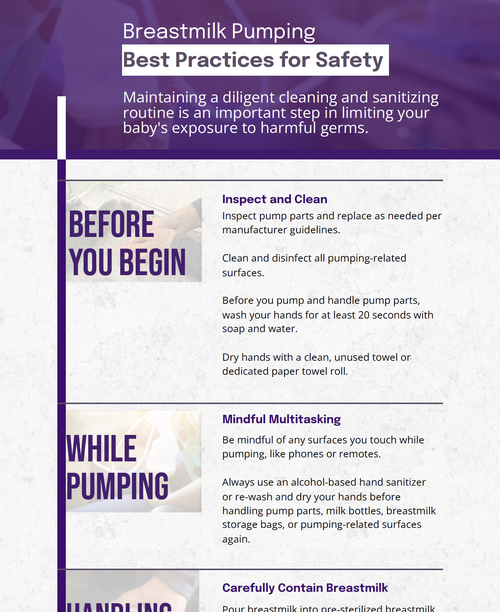Infographic
Infographic: Breastmilk pumping best practices
View as PDF


Before you begin
Inspect and clean
- Inspect pump parts and replace as needed per manufacturer guidelines
- Clean and disinfect all pumping-related surfaces
- Before you pump and handle pump parts, wash your hands for at least 20 seconds with soap and water
- Dry hands with a clean, unused towel or dedicated paper towel roll
While pumping
Mindful Multitasking
- Be mindful of any surfaces you touch while pumping, like phones or remotes
- Always use an alcohol-based hand sanitizer or re-wash and dry your hands before handling pump parts, milk bottles, breastmilk storage bags, or pumping-related surfaces again
Handling breastmilk
Carefully contain breastmilk
- Pour breastmilk into pre-sterilized breastmilk storage bags or bottles, taking care not to touch your breastmilk or insides of bags or bottles while pouring
- Be sure to label breastmilk storage bags or bottles with the date and time of expression, and if needed, the name
Storing breastmilk
Quickly refrigerate or freeze
- Place breastmilk storage bags or bottles of breastmilk directly into the refrigerator, freezer, or cooler with gel bricks
- Ideally, breastmilk should be consumed, refrigerated or frozen immediately after expression
- Be sure to follow CDC guidelinesfor breastmilk storage
Cleaning pump parts
Clean pump parts every time
- Completely disassemble pump parts and wash them individually, by hand. Cleaning should take place as soon as possible. Dried breastmilk is more difficult to clean.
- Use soap, running hot water, a bottle brush and nipple brush. Ensure all sides and crevices are scrubbed.
Cleaning equipment
Be un-friendly to germs
- Sink and basins collect and grow germs. Do not soak or store pump parts in sinks or basins.
- Sponges harbor germs and can be difficult to keep sanitary. Be sure to use dedicated, nonporous bottle and nipple brushes with bristles made from materials like nylon or silicone.
Maintain cleaning equipment
Brush care awareness
- Sanitize your bottle and nipple brushes daily
- Store bottle and nipple brushes in an upright position so that they can quickly dry
- Replace your bottle and nipple brushes periodically, at the first sign of wear and tear, or according to the manufacturer's recommendation
Sanitizing pump parts
Sanitize frequently
Sanitize pump parts at least once per day, but ideally, after each use
OR
- Boil pump parts in a rolling boil for 10 minutes
Storing pump parts
Mindful storage
- Keep sanitized pump parts in your electric sanitizer and dryer, where they will remain in
- a controlled environment
- If using the boiling method to sanitize, air dry parts on a clean, dedicated rack and store parts in a clean, air-tight container
- Keep in mind that sanitized parts can become contaminated if not stored in a controlled, sanitary environment
Think clean
Carefully consider cleaning challenges
If using a hands-free pumping bra, be sure to:
- wash it daily
- insert breast shields carefully, so not to touch the surfaces that come into contact with breastmilk
If using nipple oils or creams:
- use extra diligence when scrubbing parts as they can become more difficult to get clean
